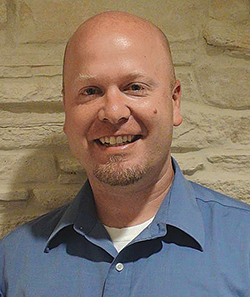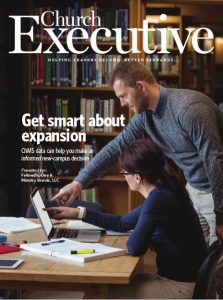

Senior Professional Services Consultant
FellowshipOne
Do most church leaders use their ChMS to its maximum advantage when determining where to open a new campus?
Matt McMaster: Based on my background, I’d say no — because many don’t know how.
I’ve worked with more than 1,000 churches, spending about three or four months with each one on their project. We dig into every aspect of their ministry — who they are, how and why they do what they do, their strengths, hang-ups, struggles.
Having said that, I believe that even if church leaders had decent data, many wouldn’t know what they’re looking for.
When a church is at the point when it’s thinking of going multi-campus or expanding its sanctuary, it’s a good opportunity to sit down with them and ask, ‘Hey, what are your goals?’ Usually, it’s some variation of growing disciples. Then I ask, ‘Are you meeting that goal right now? Do you feel confident in your approach?’ If the answer is, ‘No, because we reached the capacity of our building,’ then yes, it’s a good time to either look at multi-campus, adding a service or expanding.
Then, of course, looking at the data will give them some indicators of which path is best, and how to navigate that.
In what ways has your ChMS been enhanced to help churches practice smarter expansion?

Senior Vice President
of Marketing
Ministry Brands, LLC
McMaster: First, what’s the capacity of your sanctuary? I’m not a big fan of head counts other than for this purpose. They’re really only good for knowing whether or not your church needs to grow and expand. I’ve also seen some churches track parking spaces. Some urban congregations have sanctuaries that are big enough, but not enough parking space. Basically, they’re landlocked. So, you’d ask, ‘How many of our parking spaces are full each weekend?’ and track that in your system. If space is a limitation, then you really have to start looking at going multi-campus.
Tithing is another set of data to track. Can you even afford to go multi-campus? Look at your contributions and budgets. Our general ledger software, Shelby Financials, will help with that. You can’t expand if you’re already in the red.
When deciding where to open a new campus, what critical questions should a church leader should seek to answer using their ChMS data?
McMaster: I’ve helped churches export all the addresses out of their ChMS, and then upload them into a Google Heat Map to see where the population is in their area. That’s a great opportunity to look at the data and say, ‘Geographically, we need to put another campus over there. Maybe even a little further out in that area.’
Multi-campus starts to make particular sense when there are geographic boundary issues. And in areas where it all boils down to highways, is there one who connects everyone pretty quickly and easily — that will enable them to get to your campus a lot faster?
David Rogers: Right — when you start going into site location, that’s where the heat map piece comes in. If you have critical mass in a particular area, that’s a great place to put a new church. There are a lot of geospatial information systems (GIS) that are free or low-cost that allow you to start to put in other key factors to identify ideal locations for a new site and provide analysis like drive-time versus geodesic (as-the-crow-flies) distances. You’ll also want to be sure to incorporate demographics out of your ChMS with a lot of these geospatial platforms, once you extract relevant geographic information like address and ZIP code. Look at young families, older people, and so on. All this will help you determine if you have critical mass (people, funding, leadership) to start a new campus and have it grow.
McMaster: All that data is definitely in FellowshipOne — names, their average tithe, and so on.
You can determine, for example, if those starter families are giving enough to support the new campus. Are these new campuses likely to be self-sustaining? What percentage of those starter families would it take to support the church?
Rogers: That’s a great example of mashing up your tithing data, your member information, and your geographic data.
If critical data is not already on hand, how might church leaders collect it?
McMaster: Well, I always try to take churches back to their vision. How does that line up with a multi-campus approach?

When I ask what a church’s vision is, I usually hear a variation of, ‘We’re growing disciples.’ So, then I want to know: ‘How are you doing with growing disciples where you’re at right now?’ If they don’t have an answer, then I need to talk to them about tracking discipleship and fellowship, including key milestones — baptisms, salvations, anniversary dates, leadership training classes, discipleship classes and adult Sunday school classes.
I also consider giving data a hard indicator. It’s really critical to examine. How many people are tithing within your church? That can be hard to know, but we have some great reports in FellowshipOne that will help identify your tithers.
Churches also need to understand who their disciples are. Not every random person who walks in your church is a disciple. You need to do a really good job of maintaining your database, because if one of those disciples wanders off, you’re supposed to bring them back.
On the other hand, if three neighbor kids showed up to your church because there was a sleepover at somebody’s house, and they checked in, are they really your sheep? I don’t think they are, until they’ve committed to joining the church, or they’ve been coming to the church for X amount of time.
Then, that data can be applied to determine how your church is doing with growing disciples. Get those metrics right. Keep your data clean, track key milestones, report on things like the percentage members serving or volunteering in some capacity. What percentage of members are tithing in some capacity? What percentage are attending a bible study in some capacity?
All these data points are critical for multi-site expansion, because if you’re doing it well at the home church, you’ll know to do it well in a new location. You’ll be ready to start that new campus in keeping with your vision. Everything hangs on that vision.
After a new campus is up and running, how can ChMS come alongside church leaders to help manage it?
McMaster: Data, data, data. All the same data you’re tracking on your main campus, you’ll want to track on your satellite campus and you will want the ability to have both a total and campus view to spot trends.
Are you growing disciples? What percentage of people are serving? How long does it take to convert a first-time visitor to a first-time giver, to a member of the church, to a tither? We track all those data points in FellowshipOne, and we have reports that’ll help you better understand that data, too.
It all comes back to one question: Are you meeting your vision? Is the new campus meeting the vision? You should have some of the main data points already figured out for the home church, so you can compare those to the satellite campus. Then, you’ve got real metrics you can compare.
You might, for example, find out that 35 percent of members at the main campus are serving in some capacity, but 85 percent at your satellite campus are serving. If you find that the smaller the church, the more committed people are to serving, then you know where your focus needs to be at the main campus.
One other data element to pay attention to is who’s watching your services online. Where are they located? You might look in the database and find out there’s a bunch of people two cities away, watching.
Rogers: I agree. Doing that analysis for location using IP addresses is very powerful. Absolutely. It can even help you identify expansion opportunities in areas you might not have considered previously.
McMaster: Yes. I’ve had churches tell me they were shocked to find they had a huge population of people 45 minutes, or even four hours away. In one town, a ton of people watched the church’s worship services, so they opened a campus there, and that was all driven by researching who was watching their live-stream.
You need to think outside the box at how technology can help you identify an even larger audience, and using the geographic and member data in your ChMS can be a big driver of that decision process. Tracking that kind of data in your system can really help you decide if your church should expand even further than you imagined.
— Reporting by RaeAnn Slaybaugh


